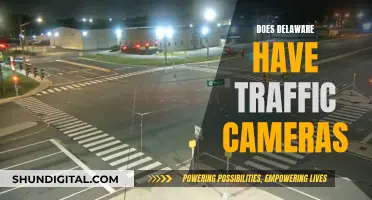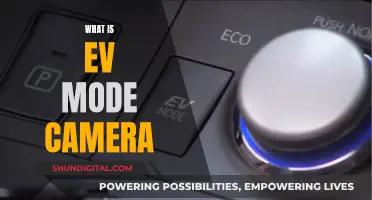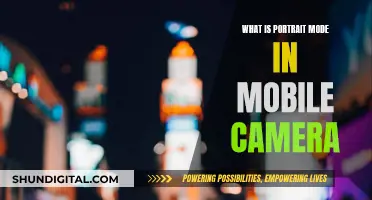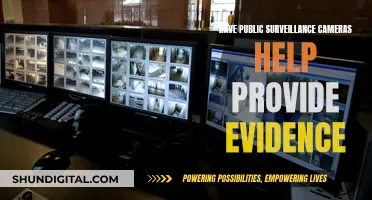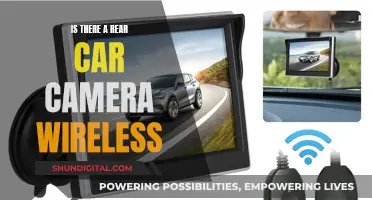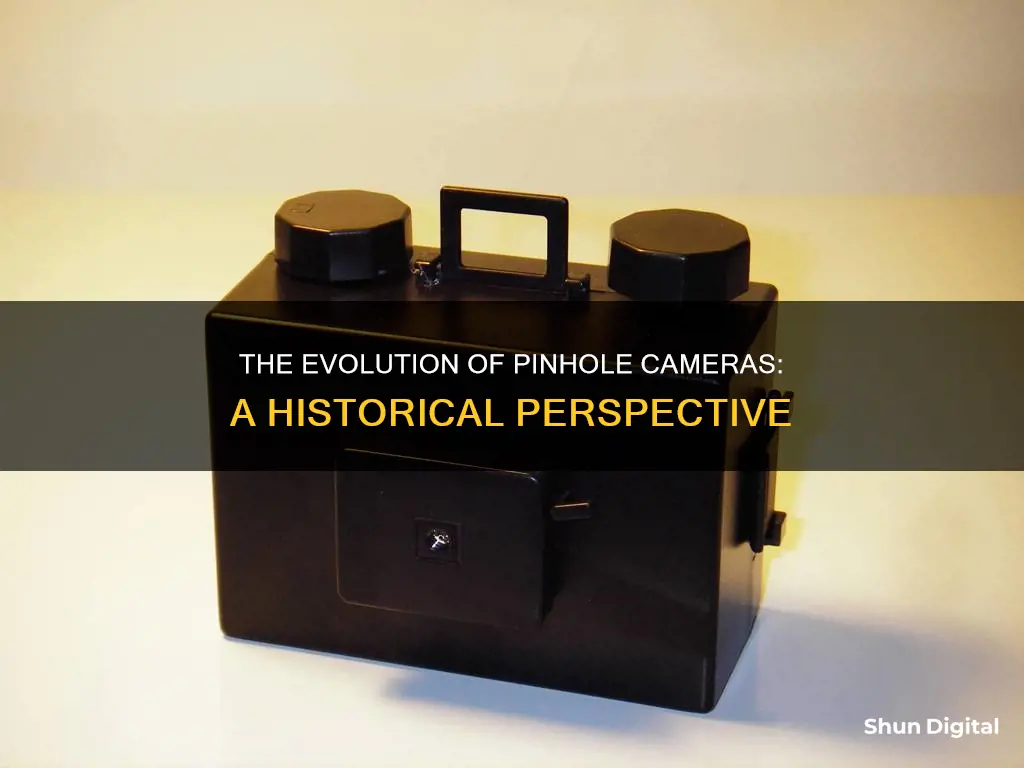
The pinhole camera is the first type of camera ever invented, predating the birth of photography as we know it. The pinhole camera is also known as a camera obscura or dark chamber, and its origins can be traced back to the 5th century BCE when Chinese scholars discovered that light travels in straight lines. The philosopher Mo Ti recorded the formation of an inverted image with a pinhole, and similar references were made by Aristotle in his writings around 330 BCE. However, it was Ibn Al-Haytham, also known as Alhazen, an Arab scholar from the 10th century, who is credited with inventing the camera obscura as we know it today. He conducted experiments with image formation and was the first to explain why the image was upside down. Over the centuries, the pinhole camera continued to evolve, eventually leading to the development of photography in the 19th century.
| Characteristics | Values |
|---|---|
| What is it? | A light-proof box with a tiny hole on one side and photographic paper or film on the other |
| First known description | Found in the 1856 book 'The Stereoscope' by Scottish inventor David Brewster |
| First known use | Aristotle wrote about pinhole images in the 4th century BCE |
| First known user | Ibn al-Haytham (965–1039), an Arab physicist also known as Alhazen |
What You'll Learn

The pinhole camera's history
The pinhole camera is the first type of camera ever invented. While the word "photography" was only coined in 1839, the pinhole technique has been known for centuries.
Ancient Observations
The first known observations of the pinhole phenomenon date back to the 5th century BCE in China. The philosopher Mo Ti recorded the formation of an inverted image with a pinhole, discovering that light travels in straight lines. Aristotle also referenced pinhole images in his writings around 330 BCE, describing how light passing through the small openings between tree leaves created a perfect projection of the sun on the ground.
Early Experiments
In the 10th century, the Arab scholar Ibn al-Haytham, also known as Alhazen, conducted experiments with image formation. He arranged three candles and a screen with a small hole, observing that images were formed only through small holes and that the candle to the right cast an image to the left, thus deducing the linearity of light.
Renaissance and Post-Renaissance
During the Renaissance and later centuries, the pinhole technique was adopted for scientific purposes in astronomy. Artists and amateur painters also utilised the pinhole camera, or camera obscura, as a drawing aid. Leonardo da Vinci made extensive descriptions of the camera obscura in his notebooks, which were deciphered and translated in the late 19th century.
In the 16th century, Giovanni Battista della Porta, a scientist from Naples, provided a detailed description of the lensless camera obscura in his book "Magia Naturalis" (1558). He is often mistakenly credited with its invention, but the term "camera obscura" was actually coined by Johannes Kepler in the 17th century. Della Porta's work popularised the camera obscura, and it soon became a common tool for artists and painters.
First Pinhole Photographs
In the 1850s, Scottish scientist Sir David Brewster was one of the first to create pinhole photographs. He also introduced the term "pin-hole" in his 1856 book, "The Stereoscope". The oldest surviving pinhole photographs were taken by English archaeologist Flinders Petrie during his excavations in Egypt in the 1880s.
Revival and Beyond
Pinhole photography experienced a revival in the mid-20th century, with artists such as Paolo Gioli in Italy and David Lebe in the US experimenting with the technique. In the 1970s, pinhole photography gained popularity, and it continues to be a thriving art form today, with enthusiasts establishing exhibitions and social media groups dedicated to the topic.
Understanding Camera Mode Dials: Unleashing Creative Photography
You may want to see also

How it works
The pinhole camera is an ancient imaging device that relies on a simple setup: a light-tight box with a tiny aperture, known as the pinhole, on one side and a piece of film or photographic paper on the other. Here's how it works:
The Science Behind Pinhole Cameras
Light from a scene enters the camera through the pinhole and projects an inverted image on the opposite side. This phenomenon is known as the camera obscura effect, and it has been observed and studied for centuries. The size of the image formed depends on the distance between the object and the pinhole, with closer objects resulting in larger images.
Construction and Design
Pinhole cameras can be constructed in various ways, from using cylindrical containers like oatmeal boxes to crafting custom wooden enclosures. The interior of the camera is typically painted black to avoid any unwanted reflections. The pinhole itself is made in a thin piece of metal, such as brass shim, and the sharpness of the image depends on the precision and roundness of the hole.
Image Formation
When light passes through the pinhole, it produces an inverted image on the film or photographic paper inside the camera. This image is a projection of the scene outside, and it is formed by the light rays converging through the tiny aperture. The image formed is softer and less sharp compared to images captured using lenses, and it has an infinite depth of field, meaning everything from nearby objects to distant ones appears in focus.
Exposure and Timing
Pinhole cameras typically require long exposure times, ranging from half a second to several hours, due to the small amount of light entering through the pinhole. Photographers often use a simple flap of cardboard or black plastic as a shutter to control the exposure time.
Applications and Use Cases
Pinhole cameras have been used for artistic, scientific, and educational purposes. Artists and painters in the 16th century utilised the camera obscura, with or without a lens, as a drawing aid. In more recent times, pinhole photography has been embraced by artists who appreciate its soft and atmospheric image quality. Scientists and astronomers have also employed pinhole cameras to study solar eclipses, the wavelength of light, and other optical phenomena.
Variations and Experimentation
Over time, photographers and scientists have experimented with different pinhole diameters, multiple pinholes, curved film planes, and various materials for construction. The versatility of pinhole cameras allows for a range of creative and scientific applications, making them a fascinating tool in the history of imaging.
Unlocking Free Camera Mode in World of Tanks Replays
You may want to see also

The camera obscura
In the 10th century CE, the Arabian physicist and mathematician Alhazen (Ibn al-Haytham) described the camera obscura effect and its usefulness for viewing solar eclipses without damaging the eyes. He wrote:
> If the image of the sun at the time of an eclipse—provided it is not a total one—passes through a small round hole onto a plane surface, opposite, it will be crescent-shaped… If the hole is very large, the crescent shape of the image disappears altogether and the light [on the wall] becomes round if the hole is round… with any shaped opening you like, the image always takes the same shape… provided the hole is large and the receiving surface parallel to it.
By the 13th and 14th centuries, different scientists were using the pinhole principle to study eclipses and the wavelength of light. In the 15th century, artists began to use the camera obscura as an aid for their drawings. Leonardo da Vinci was the first to suggest using a box to capture the image, and in the 16th century, he described the camera obscura in his notebooks:
> When the images of illuminated objects pass through a small round hole into a very dark room…you will see on paper all those objects in their natural shapes and colours… Who would believe that so small a space could contain the image of all the universe? O mighty process! What talent can avail to penetrate a nature such as these? What tongue will it be that can unfold so great a wonder? Verily, none! This it is that guides the human discourse to the considering of divine things. Here the figures, here the colours, here all the images of every part of the universe are contracted to a point. O what a point is so marvelous!
In the 16th century, the camera obscura was further developed, with the addition of lenses, and it became popular as an aid for drawing and painting. In the 17th century, a portable version of the camera obscura was introduced, first in the form of a tent and later as a box. This technology was later adapted in the 19th century to create the first photographic cameras.
Charging Camera Batteries: Field Strategies for Photographers
You may want to see also

The first photographs
The pinhole camera, also known as a camera obscura, is an ancient imaging device. The phenomenon was first mentioned by Aristotle in the 4th century BCE, who observed how light falling through an opening between the leaves of a tree created a perfect projection of the sun on the ground. However, it wasn't until the 10th century that the Arab scholar Ibn Al-Haytham, also known as Alhazen, is credited with inventing the camera obscura and studying how humans see. He performed experiments with candles and small holes in a screen, which allowed him to deduce the linearity of light.
By the 16th century, the camera obscura became popular with artists and painters, who used it as a drawing aid. Leonardo da Vinci made over 270 diagrams of the camera obscura in his notebooks, which were deciphered and translated in the late 19th century. In the centuries following Alhazen's studies, the pinhole technique was further developed and used by optical scientists to study the projection of sunlight through a small aperture.
How to Insert Batteries into Your FinePix S8200 Camera
You may want to see also

Modern-day use
Pinhole cameras are still used today for artistic reasons and educational purposes, such as teaching students about the basics of photography. They are also used in solargraphy to observe the sun's movement in the sky and in viewing eclipses.
Pinhole cameras with CCDs (charge-coupled devices) are sometimes used for surveillance because they are difficult to detect.
NASA uses pinhole cameras in space to take images of our universe.
Modern manufacturing has enabled the production of high-quality pinhole lenses that can be applied to digital cameras.
The pinhole camera's simple construction offers a number of ways it can be constructed, using various materials. The cameras can be all kinds of shapes and sizes, with various formats and types of light-sensitive material, several holes, curved film planes, etc.
You can, of course, turn your ordinary camera into a pinhole camera by simply replacing the lens with a small hole.
Exploring Adobe Camera Raw: Mastering the Undo Functionality
You may want to see also
Frequently asked questions
A pinhole camera is a simple camera without a lens but with a tiny aperture, effectively a light-proof box with a small hole in one side.
Light from a scene passes through the aperture and projects an inverted image on the opposite side of the box, which is known as the camera obscura effect.
The pinhole camera, or camera obscura, has been known for centuries, with early descriptions found in Chinese and Aristotelian writings from around 500 BCE to 600 CE. However, the first photographs using a pinhole camera were made in the 1850s by Scottish scientist Sir David Brewster.
The first pinhole cameras were simply light-tight boxes with a tiny hole on one side and photographic paper or film on the other. The box could be made from various materials such as cardboard, wood, metal, or even a cylindrical oatmeal container. A flap of cardboard or plastic served as a shutter to cover and uncover the pinhole during exposure.


